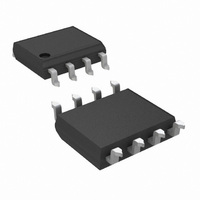LM3404HVMA/NOPB National Semiconductor, LM3404HVMA/NOPB Datasheet - Page 23

LM3404HVMA/NOPB
Manufacturer Part Number
LM3404HVMA/NOPB
Description
IC LED DRVR HP CONST CURR 8-SOIC
Manufacturer
National Semiconductor
Series
PowerWise®r
Type
High Power, Constant Currentr
Datasheet
1.LM3404MANOPB.pdf
(28 pages)
Specifications of LM3404HVMA/NOPB
Constant Current
Yes
Topology
PWM, Step-Down (Buck)
Number Of Outputs
1
Internal Driver
Yes
Type - Primary
Automotive
Type - Secondary
High Brightness LED (HBLED), White LED
Frequency
1MHz
Voltage - Supply
6 V ~ 75 V
Mounting Type
Surface Mount
Package / Case
8-SOIC (3.9mm Width)
Operating Temperature
-40°C ~ 125°C
Current - Output / Channel
1A
Internal Switch(s)
Yes
Efficiency
96%
For Use With
551600000-001A/NOPB - BOARD WEBENCH SO8/SOP LM3404/2LM3404HVEVAL - BOARD EVALUATION LM3404HV
Lead Free Status / RoHS Status
Lead free / RoHS Compliant
Voltage - Output
-
Other names
*LM3404HVMA
*LM3404HVMA/NOPB
LM3404HVMA
*LM3404HVMA/NOPB
LM3404HVMA
voltage of 200 mV. The inductor ripple current and peak cur-
rent in this condition would be equal to:
In the case of a short at the switch node, the output, or from
the CS pin to ground the short circuit current limit will engage
at a typical peak current of 1.5A. In order to prevent inductor
saturation during these fault conditions the inductor’s peak
current rating must be above 1.5A. A 330 µH off-the shelf in-
ductor rated to 1.9A (peak) and 1.0A (average) with a DCR of
0.56Ω will be used.
USING AN OUTPUT CAPACITOR
This application uses sub-1 kHz frequency PWM dimming,
allowing the use of a small output capacitor to reduce the size
and cost of the output inductor. To select the proper output
capacitor the equation from Buck Regulators with Output Ca-
pacitors is re-arranged to yield the following:
The target tolerance for LED ripple current is 50 mA
the typical value for r
required capacitor impedance to reduce the worst-case
steady-state inductor ripple current of 160 mA
A ceramic capacitor will be used and the required capacitance
is selected based on the impedance at 223 kHz:
This calculation assumes that impedance due to the equiva-
lent series resistance (ESR) and equivalent series inductance
(ESL) of C
value is 0.15 µF. The capacitor used should be rated to 50V
or more and have an X7R dielectric. Several manufacturers
produce ceramic capacitors with these specifications in the
0805 case size. ESR values are not typically provided for such
low value capacitors, however is can be assumed to be under
100 mΩ, leaving plenty of margin to meet to LED ripple current
requirement. The low capacitance required allows the use of
a 100V rated, 1206-size capacitor. The rating of 100V en-
sures that the capacitance will not decrease significantly
when the DC output voltage is applied across the capacitor.
R
A preliminary value for R
Δi
tions for Δi
SNS
L
. This value should be re-evaluated based on the calcula-
Δi
L(LED-SHORT)
C
O
O
F
Z
:
is negligible. The closest 10% tolerance capacitor
= 1/(2 x
C
I
L(PEAK)
= [0.05 / (0.16 - 0.05] x 10 = 4.5Ω
= [(48 – 0.2) x 3.3 x 10
π
= 0.5 + 0.5 x 0.598 = 0.8A
D
x 4.5 x 2.23 x 10
is 10Ω with ten LEDs in series. The
= 0.598A
SNS
was determined in selecting
P-P
5
) = 0.16 µF
-6
] / 264 x 10
P-P
is therefore:
P-P
-6
, and
23
Sub-1Ω resistors are available in both 1% and 5% tolerance.
A 1%, 0.43Ω device is the closest value, and a 0.25W, 0805
size device will handle the power dissipation of 110 mW. With
the resistance selected, the average value of LED current is
re-calculated to ensure that current is within the ±10% toler-
ance requirement. From the expression for average LED
current:
INPUT CAPACITOR
Following the calculations from the Input Capacitor section,
Δv
quired capacitance is:
To provide additional safety margin a 2.2 µF ceramic capac-
itor rated to 100V with X7R dielectric in an 1812 case size will
be used. From the Design Considerations section, input rms
current is:
Ripple current ratings for 1812 size ceramic capacitors are
typically higher than 2A, more than enough for this design,
and the ESR is approximately 3 mΩ.
RECIRCULATING DIODE
The input voltage of 48V requires Schottky diodes with a re-
verse voltage rating greater than 50V. The next highest stan-
dard voltage rating is 60V. Selecting a 60V rated diode
provides a large safety margin for the ringing of the switch
node and also makes cross-referencing of diodes from differ-
ent vendors easier.
The next parameters to be determined are the forward current
rating and case size. In this example the high duty cycle (D =
35.2 / 48 = 73%) places a greater thermal stress on the in-
ternal power MOSFET than on D1. The estimated average
diode current is:
A Schottky with a forward current rating of 0.5A would be ad-
equate, however reducing the power dissipation is critical in
this example. Higher current diodes have lower forward volt-
ages, hence a 1A-rated diode will be used. To determine the
proper case size, the dissipation and temperature rise in D1
can be calculated as shown in the Design Considerations
section. V
diode at 0.5A is approximately 0.35V and the θ
Power dissipation and temperature rise can be calculated as:
I
F
IN(MAX)
= 0.2 / 0.43 - (35.2 x 2.2 x 10
C
I
will be 48V x 2%
D
IN-RMS
IN(MIN)
for a case size such as SMA in a 60V, 1A Schottky
t
= 0.5 x Sqrt(0.73 x 0.27) = 222 mA
P
SNS
T
= (0.5 x 3.3 x 10
I
D
RISE
D
= 0.135 x 0.35 = 47 mW
= 0.5 x 0.27 = 135 mA
= 220 ns, R
= 0.047 x 75 = 3.5°C
= 505 mA
P-P
= 960 mV. The minimum re-
SNS
-7
-6
) / 330 x 10
) / 0.96 = 1.7 µF
= 0.43Ω
-6
JA
+ 0.128 / 2
www.national.com
is 75°C/W.








